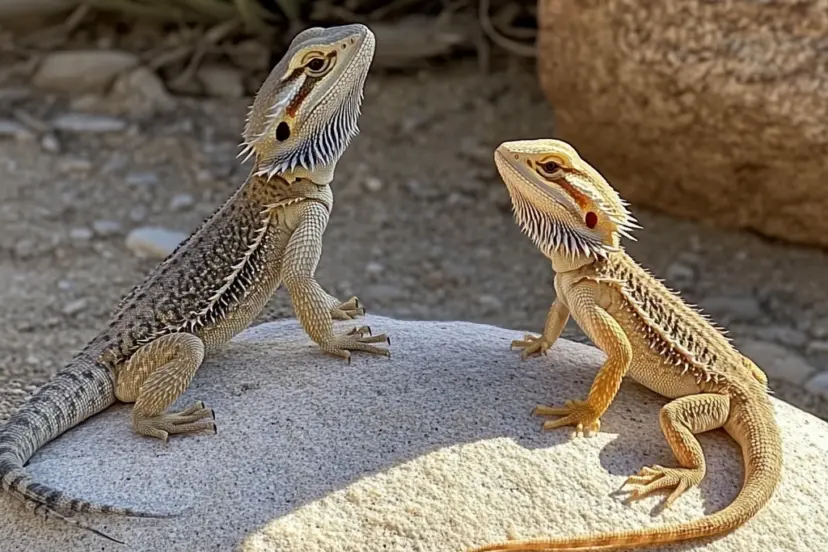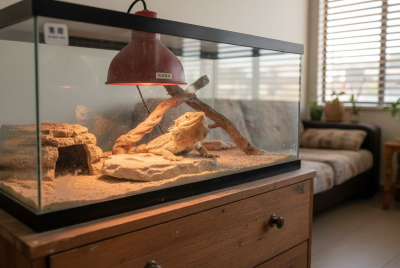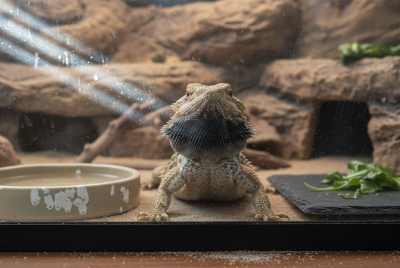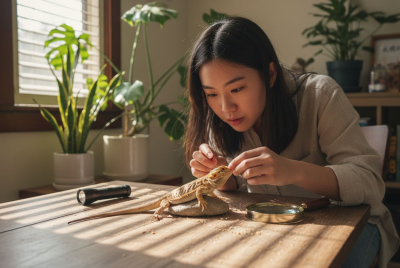Bearded Dragon Species: A Complete Guide
Bearded dragons are among the most popular reptiles to keep as pets, and it’s easy to see why. With their docile nature, fascinating behaviors, and unique personalities, they’ve captured the hearts of reptile enthusiasts around the world. But did you know there are several different species of bearded dragons? In this guide, I’ll walk you through the most common species, how they differ, and what you need to know about caring for each one.
Understanding Bearded Dragon Species
When most people think of a bearded dragon, they usually picture the Central Bearded Dragon (Pogona vitticeps), which is the most commonly kept species in captivity. However, there are a total of eight recognized species of bearded dragons, each with its own characteristics, habitat preferences, and care needs. By understanding the differences between these species, you can provide the best possible care for your pet.
The Most Common Bearded Dragon Species
While there are several species of bearded dragons, only a few are commonly seen in captivity. Let’s take a closer look at the most popular ones:
Pogona Vitticeps: The Central Bearded Dragon
The Central Bearded Dragon is by far the most popular species kept as a pet. Native to central Australia, they are known for their calm temperament and adaptability to life in captivity. These dragons can grow up to 24 inches long and come in a variety of colors, especially with selective breeding. They are also the species you’ll often see available in pet stores.
Pogona Barbata: The Eastern Bearded Dragon
The Eastern Bearded Dragon is slightly larger than its central cousin, reaching up to 24-26 inches in length. This species is native to eastern Australia and is known for its darker coloration and a more rugged appearance. While they can be kept in captivity, they are less common as pets compared to the Central Bearded Dragon.
Pogona Minor Minor: The Dwarf Bearded Dragon
If you’re looking for a smaller bearded dragon species, the Dwarf Bearded Dragon might be for you. These dragons typically grow to around 12 inches, making them more manageable for people with limited space. They’re native to western and central Australia, but they are less commonly kept in captivity.
Differences Between Bearded Dragon Species
Understanding the differences between bearded dragon species is key to providing the right care for your pet.
Size and Appearance Variations
While all bearded dragons share some common traits, such as their iconic “beard” of spiny scales, different species can vary significantly in size and appearance. For example, the Eastern Bearded Dragon tends to be bulkier and darker, while the Central Bearded Dragon comes in a wide range of colors due to selective breeding.
Behavioral Traits Across Species
Different species can also exhibit varying behaviors. Central Bearded Dragons are known for their friendly and docile nature, which makes them great pets for beginners. In contrast, the Eastern Bearded Dragon can be more territorial, especially during mating season. It’s important to consider these differences when choosing a species that fits your household.
Habitat and Environmental Needs for Different Species
Each species of bearded dragon has evolved to thrive in a specific environment, and replicating that habitat in captivity is essential for their well-being.
Natural Habitat in the Wild
In the wild, bearded dragons are found in a variety of environments, from the arid deserts of central Australia to more temperate regions. The Pogona vitticeps, for instance, is used to a hot, dry climate, while the Pogona barbata might experience more seasonal changes in temperature.
Replicating Their Environment in Captivity
To ensure your bearded dragon thrives, you need to mimic their natural environment as closely as possible. This means providing the right temperature gradient, UVB lighting, and substrate. For example, species like the Dwarf Bearded Dragon need less space due to their smaller size, but they still require a warm basking area and plenty of places to climb and hide.
Diet and Nutrition for Different Species
While all bearded dragons are omnivores, the exact diet may vary slightly depending on the species and individual needs.
Omnivorous Diet Overview
All bearded dragons need a diet that includes both insects (like crickets, dubia roaches, and mealworms) and vegetables (like collard greens, mustard greens, and squash). For younger dragons, the diet will be more insect-heavy, while adults will need a diet that consists of around 80% vegetables.
Unique Dietary Needs Based on Species
Some species, like the Dwarf Bearded Dragon, may have slightly different dietary needs due to their smaller size and faster metabolism. They may require smaller insects or more frequent feedings. Always research your specific species to ensure you’re providing the right nutrition.
Lifespan and Health of Bearded Dragon Species
The average lifespan of a bearded dragon can vary depending on the species and the care they receive.
Typical Lifespan Across Species
Most bearded dragons live between 10-15 years in captivity, but some species may live slightly longer or shorter depending on their care. Central Bearded Dragons, for example, often live on the higher end of this range due to their robust health and adaptability in captivity.
Common Health Issues to Watch For
Regardless of the species, bearded dragons are prone to certain health issues, such as metabolic bone disease, respiratory infections, and parasites. Regular vet checkups and maintaining proper tank conditions can prevent most of these problems.
Tips for Choosing the Right Bearded Dragon Species
Choosing the right species of bearded dragon involves more than just aesthetics. You’ll need to consider their space requirements, personality, and how they fit into your lifestyle.
Matching Species with Your Living Environment
If you live in a smaller home or apartment, you might prefer a Dwarf Bearded Dragon since they require less space. On the other hand, if you have more room and want a dragon with a range of color options, the Central Bearded Dragon may be a better fit.
Personality Considerations
Different species can have different temperaments. If you’re a first-time owner looking for an easy-going pet, the Central Bearded Dragon is your best bet. If you’re an experienced owner looking for something a bit more challenging, the Eastern Bearded Dragon might be a good fit.
Popular Morphs and Color Variations Within Species
One of the exciting aspects of owning a bearded dragon is the wide variety of morphs and colors available, especially within the Central Bearded Dragon species.
Morphs in Central Bearded Dragons
Selective breeding has resulted in a wide array of morphs, including the Leatherback, Hypo, and Translucent varieties. These morphs can have unique features like smoother scales or vibrant colors, making them stand out from the standard dragon.
Unique Colorations in Other Species
While the Central Bearded Dragon boasts the widest range of morphs, other species also come in interesting color variations. For example, Pogona barbata tends to be darker, while some Dwarf Bearded Dragons have more muted earth tones to blend into their environment.
Common Mistakes When Caring for Different Species
Owning a bearded dragon comes with a learning curve, and it’s easy to make mistakes. Here are a few things to avoid:
Inappropriate Tank Sizes
One of the most common mistakes is housing a bearded dragon in a tank that’s too small. Each species has its own space requirements, and failing to provide an adequately sized enclosure can lead to stress and restricted movement. Always choose a tank that’s appropriately sized for your dragon’s species and age. A Central Bearded Dragon, for example, needs a minimum of 75 gallons once fully grown, while smaller species, like the Dwarf Bearded Dragon, may be comfortable in smaller tanks but still need space to roam and explore.
Misunderstanding Species-Specific Needs
It’s easy to assume that all bearded dragon species have the exact same care requirements, but there are subtle differences. For example, certain species might have different temperature or humidity needs, so make sure to research the specific requirements of your dragon. Eastern Bearded Dragons, for instance, might need slightly cooler conditions compared to their central counterparts.
Conclusion: Understanding and Caring for Your Bearded Dragon
Choosing the right bearded dragon species is an important step in ensuring both you and your pet enjoy a long, happy relationship. Whether you opt for the more common Central Bearded Dragon or a rarer species like the Dwarf Bearded Dragon, understanding their unique needs—such as habitat size, diet, and environmental requirements—will help you provide the best care possible. Remember, each species has its own quirks, so do your homework before bringing home your new companion. With proper care, your bearded dragon will thrive, and you’ll enjoy many rewarding years together.
FAQs
- What is the most common species of bearded dragon kept as a pet?
The Central Bearded Dragon (Pogona vitticeps) is by far the most common species kept as a pet due to its adaptable nature, wide availability, and friendly demeanor. - How big do bearded dragons get?
The size of a bearded dragon depends on the species. The Central Bearded Dragon can grow up to 24 inches, while smaller species like the Dwarf Bearded Dragon typically max out at around 12 inches. - Do all bearded dragons have the same dietary needs?
While all bearded dragons are omnivores, their dietary needs can vary slightly. Young dragons require more protein from insects, while adults shift to a diet heavier in vegetables. - Can different species of bearded dragons live together?
It’s not recommended to house different species together, as they may have different habitat and dietary needs, and territorial behavior can cause stress or injury. - How long do bearded dragons live?
Most bearded dragons live between 10-15 years in captivity, though with exceptional care, some may live even longer.
This article provides a complete overview of bearded dragon species, helping you make informed decisions for your pet’s care based on its unique needs and characteristics.




